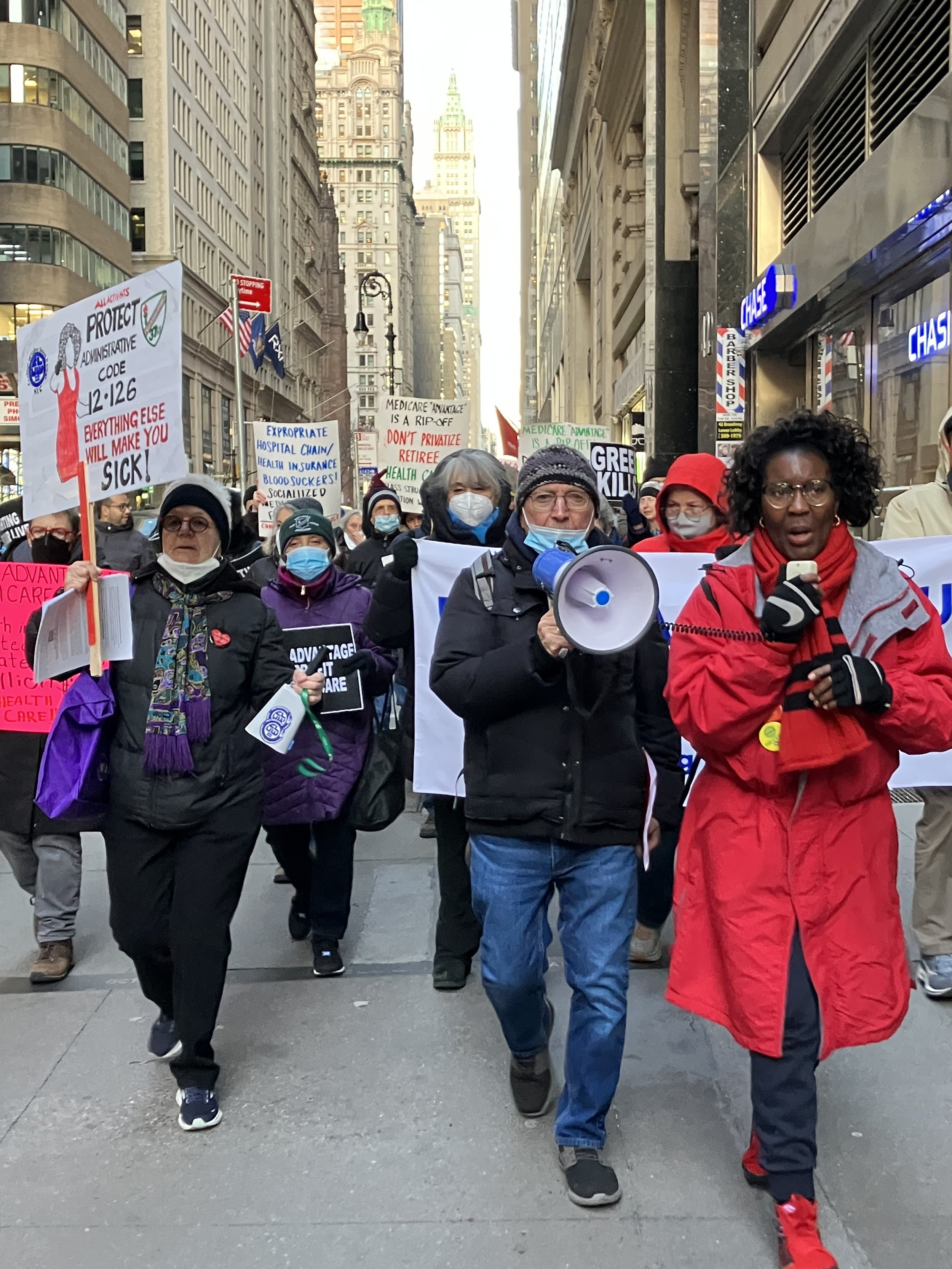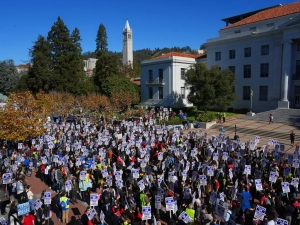NYC municipal retirees march down Broadway this week protesting the city’s ongoing campaign to push them into a for-profit, privatized Medicare Advantage plan. Photos by Joe Maniscalco
By Joe Maniscalco
New York City Mayor Eric Adams and the heads of the Municipal Labor Committee [MLC] can expect to catch a lot more hell from municipal retirees refusing to be pushed into a for-profit, privatized, Medicare Advantage plan.
Roughly one-hundred determined retirees, some of them 80-plus, rallied outside the UFT headquarters at 52 Broadway on Wednesday afternoon before marching onto the MLC offices at 55 Water Street.
“I want to keep the Medicare Senior Care I have now,” 74-year-old DC 37 retiree Aurea A. Mangual told Work-Bites. “I fear I’m not gonna be covered for the Medicare benefits that I have — and these [insurance] people are going to be denying me like they deny other people. If I need an MRI, if I need an echo cardiogram — they’re gonna start denying me, and by the time they approve it — it may be too late for me.”
Mangual recently spent 10 days in the hospital after suffering a heart attack. She spent another nine days hospitalized after complications from a certain medication caused unexpected bleeding and required a blood transfusion.
“I’m due for another surgery,” Mangual said. “I was never sick before, but now I’m starting to feel old, I guess. Everything is falling down, and even though I try to take care of my health, if it runs in the family, things happen.”
Dr. Donald E. Moore is an attending physician at NY Methodist Hospital, as well as a teacher at Weill Cornell Medical College, NYU and Hunter College. He is also board member of the New York Metro chapter of Physicians for a National Health Program.
On Wednesday, he told retirees they can expect to lose portability, access and choice if the Adams administration and the heads of the MLC are successful in pushing them into a for-profit, privatized Medicare Advantage plan.
“There’s so many plans — hundreds of those Part C plans, which means every doctor can’t be in every plan,” Dr. Moore said. “You may find one of your doctors in a plan. But the doctor [your other] doctor wants to refer you to, or you want to go to, will not be in your plan.”
“Fragmenting” traditional Medicare, Dr. Moore added, will only end up costing municipal retirees more money they can ill afford on limited incomes.
More than a year fighting against Medicare Advantage in the courts and on the streets has left many municipal retirees wondering who the heads of the MLC — UFT President Michael Mulgrew, DC 37 Executive Director Henry Garrido and Uniformed Sanitationmen’s Association President Harry Nespoli — actually represent.
“We need to let Michael Mulgrew know he is representing us — not Mayor Adams and his desire to save on healthcare costs,” Cross-Union Retirees Organizing Committee [CROC] organizer Sarah Shapiro told the rally. “I think Mike Mulgrew has lost his way; he’s not quite sure what his role is. Is he representing us and the in-service workers — or is he working behind closed doors with Mayor Adams — the so-called arbitrator Martin Sheinman, who has absolutely no jurisdiction over any of this right at this moment — and Henry Garrido and Harry Nespoli.”
Work-Bites reached out to the heads of the MLC for comment, but has not received a response.
“What we really need after a year of bitter fighting about this — is a time-out,” fellow CROC member Martha Cameron said this week.
The organization — one of a large group of New York City retiree organizations fighting to maintain their traditional Medicare coverage — supports a proposal to utilize a half-billion-dollars over the next two years from the city’s Retiree Health Benefits Trust to shore up the ailing Health Insurance Stabilization Fund — from which roughly $1 billion was diverted during the Bill de Blasio era to help pay for UFT raises.
With the Health Stabilization Fund replenished, retirees say the city can then pursue real cost-cutting measures that don’t involve throwing municipal workers under the bus. Those measures include:
*Setting up a municipal self-insurance plan for all active workers, retirees and their dependents.
*Requiring lower costs from private hospitals.
*Consolidating union welfare fund drug plans to better negotiate lower rates for all.
*Auditing current insurance providers for fraud and waste.
*Clamping down on bad insurance management and inefficiencies.
“These are just some of the ways that we can make a longterm solution to these rising healthcare costs,” Cameron continued. “If we go with the plan the MLC and the city are currently fighting for — we do not solve the issue of the Stabilization Fund being used as a slush fund.”
Despite her health challenges, Mangual remains Associate Vice-President for Inter-Union Relations at the DC 37 Retirees Association.
On Wednesday, she reiterated a call made at an earlier DC Retirees Association meeting for members to stop donating to the group’s political action committee.
“Do not give them any more money,” she said, “because we don’t want them to use our money to help political people coming up, while they are hurting the retirees and [active] members.




